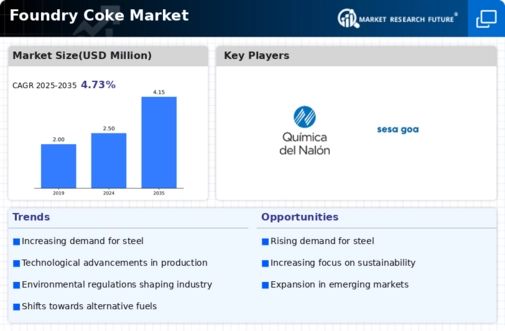HIGH DEMAND FOR CAST IRON IN THE AUTOMOTIVE INDUSTRY
Foundry coke is primarily used as a fuel in cupola furnaces to make molten iron, which is subsequently cast to produce various cast iron products in several forms and sizes. Metals account for around 80% of total vehicle weight in the automotive industry, with plastic, rubber, glass, paint, and textiles account for the remaining 20%. Steel, sintered metals, aluminum alloys, magnesium alloys, metal-based composite materials, and different ceramic and metallic coatings are among the most regularly used metals in the automotive industry.
Austempered Gray Iron (AGI) and Austempered Compacted/Vermicular Graphite Iron (ACI/AVI) are two novel varieties of Austempered cast irons that have been created in recent years. Cast iron goods are used to make engine parts, suspension, brakes, crankshafts, steering, gears, and bushings, among other automotive components. Although cast iron components are heavier than steel, aluminum, and other composite metals, they have a number of advantages, including remarkable dimensional stability, which makes design easier in automotive industry, excellent vibration absorption, high durability, cost-effectiveness, and recyclability.
Cast iron is commonly used in the fabrication of components for huge commercial vehicles and tractors that require high horsepower engines.
The global automotive sector is predicted to rise due to rising per capita income, improved living standards, and increasing automobile manufacturing, which is expected to enhance demand for cast iron and, as a result, promote the expansion of the Foundry Coke Market during the forecast period.
Furthermore, cast iron is also used to some extent in the manufacturing of electric vehicle components. The investments in the manufacturing of electric cars are increasing significantly worldwide. According to the data published by the International Energy Agency (IEA), there will be 125 million electric vehicles (EVs) on the road by 2030. According to Bloomberg New Energy Finance (BNEF's), Europe is expected to hold the largest share of the electric vehicles market by 2030.
Thus, with the increasing manufacturing and sale of electric cars, the demand for cast iron components is likely to increase, which consequently is projected to boost the growth of the Foundry Coke Market during the forecast period.
GROWING INFRASTRUCTURE AND CONSTRUCTION ACTIVITIES
The foundry coke market has been experiencing a significant surge in demand, primarily driven by the rapid growth of infrastructure and construction activities globally. As nations strive to improve their infrastructure to support urbanization, economic development, and industrial growth, the need for materials that can withstand the rigors of construction has increased. Foundry coke, a vital component in the production of iron and steel, is essential for various construction applications including the manufacturing of rebar, structural steel, and other materials crucial for building roads, bridges, and buildings.
One of the primary drivers behind this demand is the expansion of transportation networks, including roads, railways, bridges, and tunnels. These projects require vast amounts of steel, which is produced using foundry coke in blast furnaces. The construction of commercial and residential buildings, particularly in rapidly urbanizing regions, also contributes to the rising demand for foundry coke. Governments and private sectors are investing in smart cities, housing projects, and commercial spaces, further boosting the consumption of steel and, consequently, foundry coke.
According to China-Britain Business Council, in August 2022, the government of China has announced an investment of USD 1 trillion for the growth of infrastructure megaprojects providing a boost to the construction industry. Moreover, according to the India Brand Equity Foundation, India has to enhance its infrastructure to reach its 2025 economic growth target of USD 5 trillion. Additionally, the government has demonstrated a strong commitment to developing future-oriented infrastructure through a series of recent initiatives.
Notably, the Gati Shakti plan, with a budget of USD 1.3 trillion, has emerged as a frontrunner in driving systemic and effective reforms in the sector yielding significant progress. These initiatives have also had a positive impact on programs such as the "Smart Cities Mission" and "Housing for All." Additionally, Saudi Arabia has expressed its intent to invest up to USD 100 billion in India, spanning various sectors including energy, petrochemicals, refinery, infrastructure, agriculture, minerals, and mining.
Moreover, in 2024, the European Commission has announced the selection of 134 transport projects that will receive more than Euro 7 billion in EU grants from the Connecting Europe Facility (CEF), which serves as the EU's strategic investment tool for infrastructure. This funding marks the largest allocation under the current CEF Transport program. Notably, approximately 80% of the total funding will be directed towards rail projects, reflecting a strong commitment to enhancing and modernizing the EU's transportation network. These collective efforts demonstrate the commitment of governments and organizations to establish strong infrastructure frameworks, drive economic growth, and foster sustainable development.
The demand for foundry coke is expected to remain robust, driven by the ongoing expansion of the steel and casting industries, which are critical to infrastructure development and manufacturing processes.
U.S. Energy Information Administration













Leave a Comment